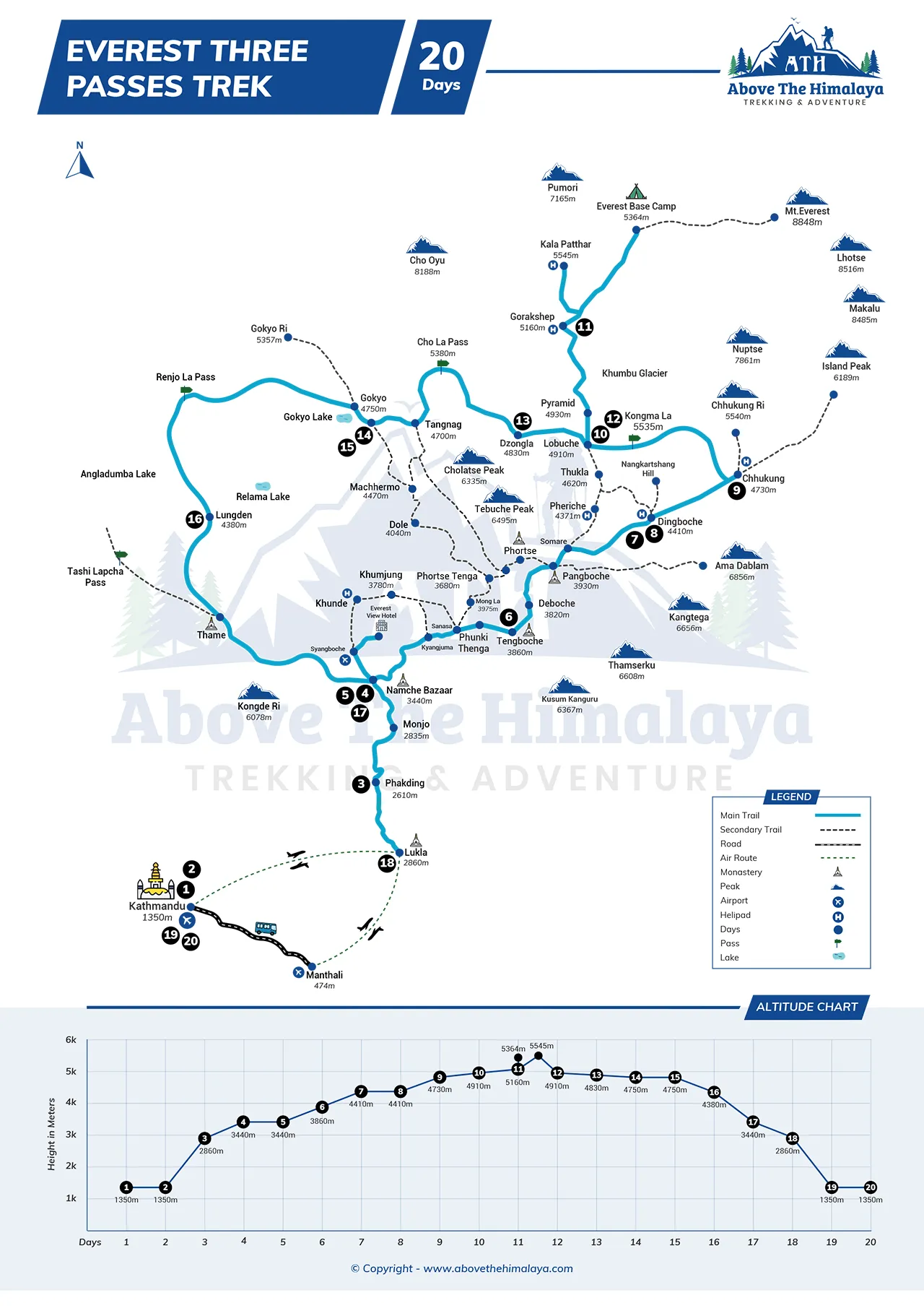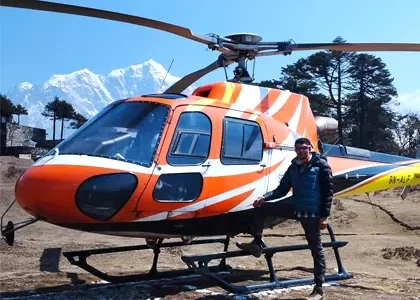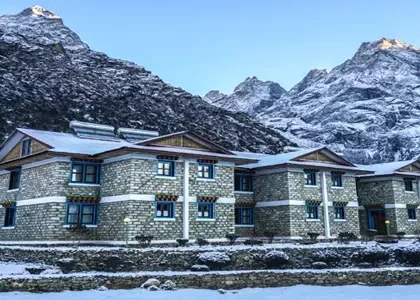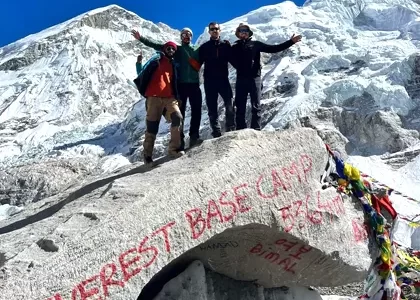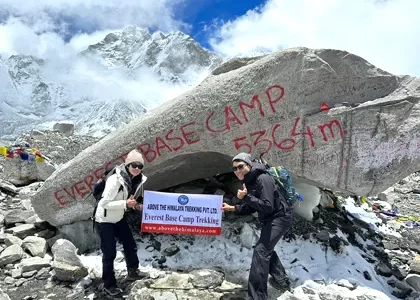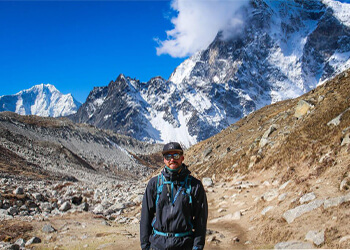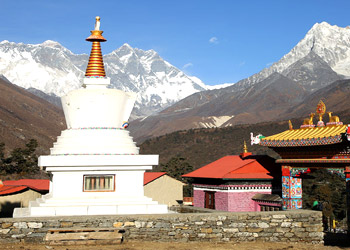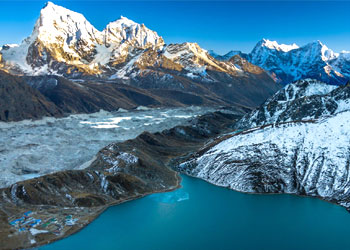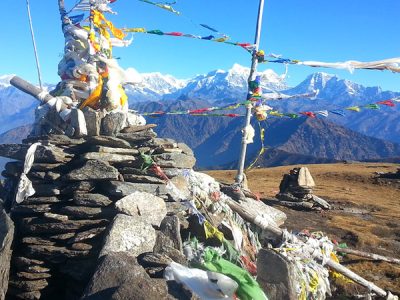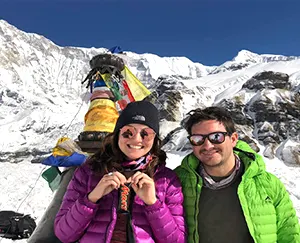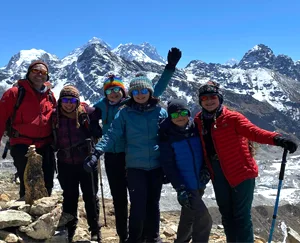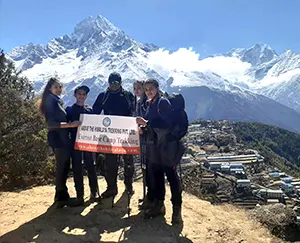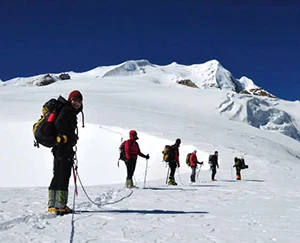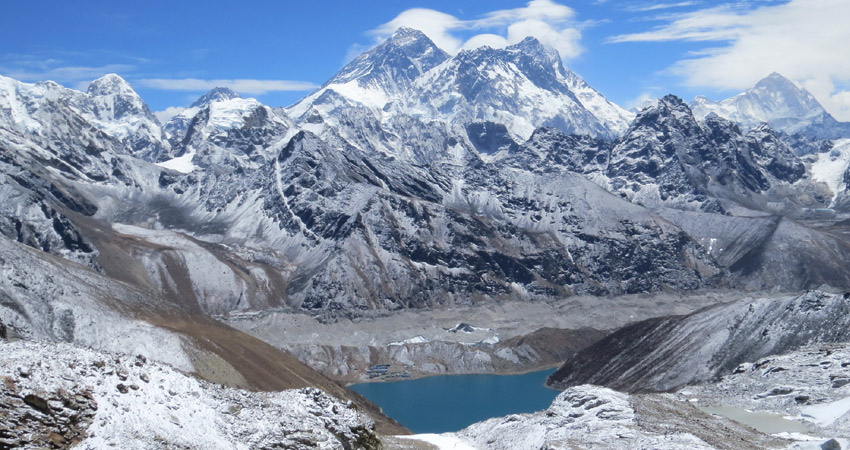
Everest three passes trek

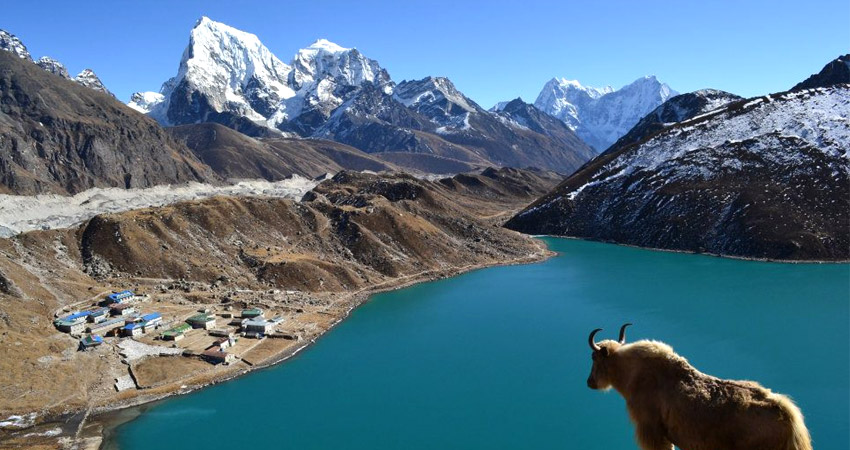
Small Group Departure Dates for 2025 and 2026
Note: We can run a trip for solo travelers, couples, friends, and family with children. Our private trips run daily. For small group travel, please check the dates below. If the dates below do not suit you, please email us or WhatsApp us at +9779851095800 to travel on your preferred dates.
Highlights of Everest Three Pass Trek
- Kathmandu monuments tour with Swayambhunath, Pashupatinath, Boudhanath, Durbar Square
- A unique Himalayan flight toward Lukla
- Conquer the three high King Passes of Everest
- Stand at the historical Everest Base Camp
- Enjoy the exceptional landscape and the unique panoramic Himalayan Views from Kala Patthar and Gokyo Ri
- Engage with the rich Tibetan heritage of the Sherpa people and see their age-old monasteries
- Discover the out worldly Gokyo Valley and its lakes
- Hike through all types of terrain in one adventure
- Embrace the challenge with adventure
- Fully supported the journey with plenty of acclimatization between the treks
Overview of Everest Three Passes Trek
Join our Above the Himalaya team into the extraordinary Everest region of Nepal on the Everest Three Passes trek. Counted as one of the most stunning, exciting and the most desirable adventure, the Everest three high passes trek offers you the choice of less crowded and stunning alternative to the renowned Everest Base Camp trek.
Our Everest three passes trek trail will lead you to the three high King passes in the Solukhumbu Valley of Nepal: Kongma La (5535 m), Cho La (5420 m), and Renjo La (5345 m), also making our way to the iconic Everest Base Camp (5364 m).
Beyond these passes, our Everest three pass trek will also lead you to four other important landmarks: the Everest View Hotel (the highest in the world at 3880 m), Nagarjung Peak (5050 m), Kala Patthar (5644 m), and Gokyo Ri (5357 m), along with the stunning Gokyo Lakes.
Made for the experienced trekkers, our Everest three passes trek is a tough physical journey that requires long hikes along the demanding trails. However, be assured the trek does not require advanced climbing and technical skills; hiking poles and crampons (depending on the weather and the condition) may suffice.
Additionally, the route that we have chosen for you ensures that you wont repeat the path on your way back along with the plenty of opportunity for acclimatization.
Throughout our Everest three passes trek, you will frequently surpass the altitude above 5000 m watching the landscape and the nature that are truly out of this world.
Khumbila (5,761 m), Pumori (7,165 m), Everest (8,848 m), Taboche (6,495 m), Lhotse (8,516 m), Gaurishankar (7,134 m), Ama Dablam (6,812 m), Nuptse (7,861 m), Thamserku (6,608 m), Makalu (8,485 m), Kusum Kanguru (6,367 m), and Kongde Ri (6,187 m) among others are the magnificent peaks that you will see on the entire route.
Our Everest three passes trekking route will also take you through the remote rural mountain communities, lush green deep forests, gorges, glacial valleys, and the high altitude rocky terrain.
You will also get to explore the isolated peaceful Gokyo Valley and its high alpine Gokyo Lakes. Additionally, as you trek through the iconic Sherpa villages of Namche, Dingboche, Tengboche, Lobuche, Dzongla, and more, you will also experience their rich Buddhist traditions and warm hospitality.
Their ancient, mysterious monasteries and the trails adorned with Mani Walls and chortens will delight your eyes and fulfill your overall journey.
Everest three passes trek will first take you on an adventurous Himalayan flight towards Lukla from where the excitement begins. Passing through the green deep forests alongside the Dudh Koshi, Bhote Koshi, and Imja Rivers, you will gradually make new discoveries.
At first, you will ascend the Kongma La Pass then head towards EBC and Kala Patthar. Then you will head to the Gokyo Valley through Cho La Pass. On your way back to Namche, you will traverse the Renjo La Pass and head towards Kathmandu through Lukla.
In short, Everest three high passes trek is a complete and fulfilling journey that we promise will be an inseparable part of your life. Join us on this thrilling trek and add a unique chapter to your life with Everest.
Itinerary of Everest Three Passes Trek
01
Day 01: Welcome at TIA, Kathmandu (1350 m) and Hotel Transfer
The uniquely beautiful Himalayan capital of the world is pleased to embrace you. Please complete all the Visa and customs formalities at TIA after which you will have a warm short reception by our friendly Above the Himalaya representative.
Driving through the narrow colorful and crowded streets, you will reach your selected hotel within half an hour. Take some time to revive yourself from a long journey.
Once all the guests of our Everest three pass trekking are in the hotel, our guide will offer you a short detail about the journey. Then you can tour the nearby location on your own or with our guide to enjoy the vibe of Kathmandu.
02
Day 02: Sightseeing around Kathmandu
Quickly get ready early in the morning for a guided tour of the Kathmandu city. For our comfort, we will have our own transport to focus our visit on Boudhanath, home of the magnificent Buddhist stupa, the Swayambhunath Temple, home of the playful monkeys, Pashupatinath Temple with its cremation site on Bagmati River, and the royal palace square of Kathmandu.
Please rest early in the evening as we may need to begin our Lukla journey around midnight.
Note:
Kindly be informed that the straight flights to Lukla from Kathmandu may get suspended during the autumn, spring, and adverse climatic conditions.
In such case, the flight will be rescheduled through Ramechhap to Lukla for which a 4 to 5-hour road travel around midnight from Kathmandu will be needed.
On the return trip, the same condition may also apply. We will look after the Kathmandu- Ramechhap transportation through private transfer.
03
Day 03: Fly from Ramechhap to Lukla (2840 m), 20 minutes, or from Kathmandu to Lukla 30 minutes, and trek to Phakding (2652), 3 hours
Today the adventure of our Everest three high passes begins with the magnificent flight over the fertile plains, lush jungles, and the magical profiles of Kanchenjunga, Jugal, Everest, Makalu, and Langtang towards the most exhilarating airstrip of the world.
Once landed, we will meet our rest of the trekking team and enjoy a hot sip of tea with Mont Kongde Ri. Now, we will start to walk down beside the marvelous current of Dudh Koshi towards Chheplung, Chaurikharka, Thadokosi, and Ghat.
We can see beautiful glimpses of Khumbila and Kusum Kanguru as we proceed toward Phakding for our first mountain sleep.
04
Day 04: Phakding trekking to Namche Bazaar Trek (3440 m), 5 to 6 hours
From Phakding, we will take the northern route beside the Dudh Koshi and proceed towards Monjo through Benkar. Here, we enter the Sagarmatha National Park and have our permits examined.
Now, the steepening trail will lead us toward Jorsale (2810 m) with beautiful Thamserku shining in the sky. Climbing gently for about 30 to 40 minutes, we will arrive at the point where the three rivers meet: Dudh Koshi with Bhote Koshi and Imja.
Here, about 60 km long Hilary Bridge extends over with marvelous Tarboche (6495 m) in view. The path across now steepens more leading us atop 3140 m Top Danda.
Namche is one more hour sharp climbing far and soon we will see the King- His Royal Highness the Everest on the horizon. Facilitated by all the comforts and the splendid nature, we will sleep two nights at Namche.
05
Day 05: Acclimatization day in Namche
Today we have the first of our planned acclimatization days in our Everest three passes trek. Instead of remaining inactive, we can take a short tour of the Village, and explore its shops and bakeries.
But the ideal walk will be towards the Khumjung Village (3790 m) and its monastery and on the way back to the Everest View Hotel, the 3880 m tallest hotel on the planet.
The surroundings of the hotel are like the natural playground of the towering giants such as Nuptse, Cholatse, Taboche, Ama Dablam, Lhotse, Thamserku, and Everest.
06
Day 06: Trek from Namche bazar to Tengboche
From Namche, we will follow the slowly rising trail that runs through the wooded gorge of the river. We will then walk across some open hills before climbing down towards the Dudh Koshi River.
Shortly, the rushing waters of the Imja Khola will usher us upward towards the 3250 m high Phungi Thanga. Up till now, the vertical trail was easy but it will now turn a bit challenging and sharp for around two hours ultimately taking us to the vibrant Monastery of Tengboche.
The inside of this monastery contains several murals and statues and we can also see monks from young to old each playing their part. Far in the sky, we can look at Everest, Kongde Ri, Nuptse, Thamserku, Lhotse, and Ama Dablam.
We will now resume our hike to our overnight lodge to enjoy the finest dinner over the warmth of the stove.
07
Day 07: Trek from Tengboche to Dingboche
We will have a very attractive and delightful trail today lined with the series of roadside Gompas and Mani Walls. From Tengboche, we will ascend for a few moments till are are at Debuche Village.
Ama dablam dominates the sky as we proceed towards the hung bridge over the Imja Khola. The trail on the other side will gently climb us till we are the meeting point of two trails.
The trail running to left climbs up to Upper Pangboche and the right one to lower. We will follow the right one and follow the route mixed with small climbs and flat stretches.
We will walk by Orsho and Shomare before we are at the potato fields of Dingboche where we will call it a day and eat our home cooked dinner with Taboche, Ama Dablam, Thamserku, Nuptse, Lhotse, Cholatse, and more.
08
Day 08: Acclimatization Day at Dingboche
The second beautiful day to rest on our Everest three pass trek. You can either give your body a complete rest or take the short 700 m upward climb towards the ridge of Nangkartshang or Nagarjun at 5050 m.
The journey will take approximately 3 to 4 hours with the excellent panorama of Makalu, Cholatse, Thamserku, Island Peak, Baruntese, Ama Dablam, Lobuche and Taboche.
09
Day 09: Trek from Dingboche to Chhukung
We have a very short and pleasant climb today as we leave Dingboche for Chhukung Village- a staging post for the Everest Three Passes trek or Island Peak Expedition.
The enchanting track runs alongside the towering walls of Lhotse, Ama Dablam, and Nuptse. Soon, we will find ourselves climbing vertically over the rocky terrain till we reach the Chhukung Village.
Surrounded by the icy walls of Makalu, Kongde Ri, Karyolung, Cholatse, Tawache, Numbur, and Lhotse, the village also houses the 5546 m Chhukung Ri Ridge which you can choose to climb.
However, we suggest you get to rest as we have a very long demanding hike tomorrow.
10
Day 10: Trek from Chhukung to Kongma La Pass and Lobuche
Waking up before the sun does, we will quickly pack our lunch and prepare to set forth for the crossing of the most difficult and the highest among three Everest Passes: the Kongma La.
From Chhukung, we will take the north trail and head up towards the glacier wall of Nuptse. We will climb through Bibre and step inside the Nyiang Valley closed on both sides by the Pokalde and the Chhukung Ri.
Now the western rising track will carry us forward for another 3 to 4 hours till we are at the front of the few mountain lakes. Finally, the Pass and its summit are below our feet and we stand between Pokalde and Kongma Tse.
Makalu, Lhotse, Pumori, Everest, Gauri Shankar, Lobuche, Ama Dablam, and Nuptse will be smiling upon us at the top of this massive pass. Its now time that we climb down carefully to the bottom of the pass.
We will then take the Khumbu Glacier as our guide till we are at Lobuche for our evening meal and rest.
11
Day 11: Trek to Gorakshep and Everest base camp
From Lobuche, we will first hike along the relatively even trail that runs through the Khumbu Glacier. We can view the extraordinary glass pyramid building of the international High Altitude Scientific Research Center.
Shortly after, we will overcome the distinct wall of the Changri Nup Glacier which is called the Lobuche Pass commonly. After crossing the glacier, we will reach the last stop of Gorakshep before the EBC where we will take some rest and a meal to recharge.
Now, we will climb the main trail from Gorakshep comprising of rocks and snow for around 2 to 3 hours to reach the dream destination of Everest Base Camp.
The prominent icy figure of the Khumbu Icefall will make our heart miss a beat while the splendid features of Lhotse, Pumori, Nuptse and Khumbutse will beat our heart faster.
After some worth remembering moments, we will now travel back down to Gorakshep for our night refuge.
12
Day 12: Trek from Gorakshep to Lobuche via Kala Patthar
Today we will literally be at the top of our Everest three passes trek. From Gorakshep, we will once again rise before the sun and take on the other trail that climbs over the Khumbu Glacier.
The trail will start to incline more and more and we will have to traverse few boulders as well. Finally after around 2 hours, we will be standing above Kala Patthar.
The views of Everest, Khumbutse, Lobuche, Changtse, Lhotse, Lingtren, Ama Dablam, Nuptse, and Pumori bathing under the sun will outshine anything you have witnessed so far.
We will take some time to appreciate this outstanding beauty of the Himalayas after which we will descend back to Gorakshep for breakfast. Then we will traverse back to Lobuche for our overnight sleep and dinner.
13
Day 13: Trek from Lobuche to Dzongla
From Lobuche, we will follow the main path for a few moment. Then we will direct towards the mountain track along the slabs of rock. Soon we will meet the Cho La Lake which we will cross along the hanging bridge.
The path across will rise through the extraordinary wonderland which will finally take us through vast pastures to the destination of Dzongla.
14
Day 14: Trek from Dzongla to Gokyo Lake via Cho la pass
Today also, we will set off into the darkness to cross the mighty height of the Cho La Pass. The initial trail will climb alongside the mountain stream ad through pasture until we ascend the sharp slope to the tail of the pass.
We will then traverse some gentle terrain before making a significant ascent on steep, rocky ground. The trail now consists of the glacial landscape where we may need the use of crampons.
Finally, we will be at the wide ridge of the Cho La from where the we can see the striking features of Lobuche East and Rolwaling Peaks. We will now prepare for the descent from the pass where we may have to seek help from the attached rope on some steep sections.
Soon, we will be at Dragnag or Thangnak, a pleasant spot for our lunch. Now, we will climb over the ridge and pass through the longest Ngozumpa glacier for around 2.5 hours.
Our target- the Gokyo Lake is on the west of this glacier. Climbing along the glacier side wall, we will first arrive at the Longponga- the first one of the Gokyo Lake system.
A little further we will come cross the Taujung, the second Gokyo Lake and later we will meet the third and the biggest Gokyo Lake- the Gokyo Cho or Dudh Pokhari.
For now, we will seek refuge in one of the beautiful hotel by the lake side and relax in front of Kangtega and Cho Oyu.
15
Day 15: Rest day at Gokyo lake
Today either early in the morning or later in the day, we can opt to climb the 5357 m high Gokyo Ri Ridge which is regarded as one of the best view point after Kala Patthar.
The ascension will not that be lengthy or strenuous ( 2 to 3 hours). Once at its top, we can admire the beautiful silhouettes of Everest, Island Peak, Lhotse, Cho Oyu, Nuptse, Makalu, and Pumori.
We will now walk back down to our lodge in Gokyo and spend the rest of the day relaxing.
16
Day 16: Ascend the Renjo La Pass (5345 m) and hike down to Lungden (4370 m), 7 to 8 hours
The last pass of our Everest three pass trek awaits us today: the Renjo La which is the simplest among the three. Technically, Renjo La is not problematic but the descent from the pass can be long and tiring but the stairs will help us out.
From Gokyo, we will walk along the Gokyo Ri and begin to climb over the endless slope. A 3 to 4-hour laborious climb will finally take us to the tail of the pass.
The trail will now become moderate and winding till we are the Pass summit. The trinity of Makalu, Lhotse and Everest seen very spectacular from this height. Several other frozen 6 and 7 thousand meters peaks also shine in the background.
We will now graciously walk down the pass and proceed down to Bhote Koshi Valley Village Lungden.
17
Day 17: Trek to Namche bazar
From Lungden, we will begin our downstream journey till we are at Namche. Walking down further along the Bhote Koshi River, we will soon reach the Thame Village through Marlung.
We can see the village is protected by the prominent walls of Kongde Ri and Thyangboche. We can explore its majestic Gompa for a while, then we will resume our downward hike again and walk down past the Thamo Nunnery before we arrive at the known comfort of Namche.
18
Day 18: Treking back to Lukla
The familiar route through Phakding and Ghat will take us back to Lukla today where we will celebrate a successful Everest Three passes trek with our Sherpa team.
19
Day 19: Flight from Lukla to Ramechhap and drive to Kathmandu
In the morning, we will either fly to Ramechhap and then return to Kathmandu by private transport or we fly straight to Kathmandu. This is the conclusion of our Everest three pass trekking adventure but it is not the end of attractions.
In the evening, we will enjoy the last evening together crowned by the special farewell dinner with a cultural dance show in a unique location of the capital.
20
Day 20 : Departure
We will transfer you to TIA for your journey back home. See you on our next adventure soon in Nepal.
Trip Extension
Suppose you have more time in Nepal after this trip. In that case, we can help you to extend your trip by running different treks in Nepal, tours in Bhutan and Tibet, Jungle safari tours at Chitwan, Bardia, and other National parks, Nepal luxury hotel booking, Rafting, Ultra-light flights, or any other travel-related services. You can get more information here.
Includes/Excludes
What's Included?
- Kathmandu Airport to Hotel and back to Airport transfers by tourist coach.
- Your hotel twin-sharing accommodation in Kathmandu includes breakfast.
- Complimentary day tour of Kathmandu valley with good English-speaking tour guide, private car, and driver.
- A trekking guide certified and licensed by the Government and has training in high altitude sickness and first aid.
- Local trekking porter from Lukla
- Trekking staff, food, accommodation, salary, equipment, insurance, and clothing.
- Kathmandu to Lukla and back Kathmandu flight ticket.
- Local Tea houses, also called guest houses/ lodges, twin sharing during your journey.
- Your daily meal (breakfast, lunch, and dinner). You can choose your meals from the menu. There are different types of food available.
- Sagarmatha National Park Everest trekking permit
- Local permit fees for Khumbu Gaunpalika
- The guide will carry essential medical supplies and first aid kits.
- Above the Himalayan duffel bag. ( If you need it too, please let us know before you book the trip and remind us before you arrive in Kathmandu so that it is easy for us to prepare.)
- All the trip information and details for the trek.
- Above the Himalayan Gifts and Trekking certificate after finishing your trek.
- We offer you one dinner in Kathmandu in a Nepali restaurant
- Government taxes and service charges.
What's Excluded?
- Meals in Kathmandu, except for breakfast at your hotel.
- Airfare to Nepal, Kathmandu city tour entrance fees.
- Nepal entry visa fee. You can get a Nepal visa upon arrival at the Airport.
- Alcoholic, hot and cold drinks, hot water, hot and cold showers.
- Personal expenses include laundry, telephone calls, sweets, snacks, beverages, bar bills, and camera battery charging.
- Travel Insurance should consist of both rescue and medical assistance.
- Personal trekking equipment you can buy and rent in Kathmandu trekking stores
- Gratitudes for tour/ trekking staff and driver
- Other of your expenses not mentioned cost includes section.
Route Map & Altitude Chart
Everest Three Passes Trek: Best Season
The dry climate, stable weather, minimal rainfall, and excellent visuals are the key elements needed for any trekking adventure around the world.
The Everest region experiences varied weather pattern based on its altitude but the climate is much influenced by the monsoon rain that begins from June and lasts till August.
During this time, increased rainfall can quickly transform walkable trails into muddy rivers, and thunderstorms may obstruct the high passes advancement.
On the other hand, the harsh winter commencing from December and lasting till February blankets the region in deep snow, often blocking trails to the Passes and plunging nighttime temperatures below freezing.
Therefore, the most favorable weather for the Everest three passes trek occurs in autumn beginning from mid-September and lasting till November.
During this period, the forests clear, the unobstructed view of the hills and Himalayas open up basking in the sun and the temperature is also consistently pleasant ideal for longer hikes.
The another best time for the Everest three high passes trek occur in Spring beginning from March till May. Although light rain may occur, but the days grow longer, the sun shines brighter, and the barren landscapes of Everest glow with pinkish hue from blooming rhododendrons.
Everest Three High Passes Trek: Difficulties and Challenge Level
If you decide to undertake our Everest three high passes trek, know that it is a challenging level 5 route that consists the crossing of not one, not two but three high King Passes of Everest region along with ascents to Kala Patthar and Gokyo Ri.
This adventure can drain your energy more than any other trek in the region so being prepared physically and mentally is very essential. Right from the commencement of the adventure, you will have the hardship of overcoming the unstable terrain that can be snowy, icy, rocky and slippery.
The trails leading to the passes are also not well signposted so getting confused on the journey is another difficulty. However, the most serious threat comes from the high elevation as most of our trekking journey and sleeping will occur at 5000 m or above.
Among the three high Everest Passes, the tallest and most demanding one is the Kongma La Pass because of some steeply inclined sections and long descents over large boulders.
On the other hand, the Everest Base Camp trek involved in the adventure is not light either. This moderate route will also test your capability of walking and your determination of seeing Everest.
However, the trekking trail throughout our Everest three passes trek has zero level of technical difficulties and acclimatization will also occur gradually reducing the concern of altitude sickness.
The distance that we will covering during our 20 days journey is around 166 km with 6 to 8 hours of walking involved most of the days. Thus the Everest three passes trek is one of the tough trek filled with adventure and adrenaline rushing experiences.
Who is eligible to participate in our Everest three pass trekking adventure?
Our level five Everest three passes trekking adventure is more perfect for those who have already conquered and walked through several high altitude terrain in Nepal or anywhere else in the world.
However, if you posses prime health, fitness, resilience and determination, then even if you are a beginner or a newbie to the world of high elevation trekking, then still you can participate in our Everest three passes trek.
To make this journey much suitable for a beginner hiker, we can eliminate the trekking part to the Everest Base Camp, Kala Patthar and Gokyo Ri.
Still, the terrain will be tough and the walking will be long. There will still be three high passes standing on your way so be ready to give all the strength and endurance that you have on this journey.
Therefore, for the new hikers, we suggest you try first the Everest Base Camp Trek, or Gokyo Valley Trek so you will be pre-acclimitized before undertaking this journey.
Please remember, if you have joint problems, fear of heights, and have circulatory, musculoskeletal, or respiratory issues, we suggest you see your doctor first. Tell him all about the nature of this trip and take part only after his approval.
Acute Mountain Sickness/AMS with Acclimatization, Prevention and Treatment
Yes, the challenge of high altitude without a doubt is present in our adventure of Everest three high passes trek and so the sickness related to the altitude- the altitude sickness or AMS is also present.
The onset of this condition generally occurs in adventurers from 3000 m elevation where we will be from fourth day of our Everest three passes trek. And before reaching the Everest Base Camp, we will tackling the 5535 altitude of the Kongma La Pass.
This is the stage where most of our hikers begin to feel the generally mild symptoms of AMS such as sleep disturbances, appetite loss, fatigue, dizziness, nausea and severe headache.
In order to minimize the onset of AMS on this section, we have included a day off first in Kathmandu then at Namche and Dingboche allowing you to get used to the high Everest Pass air as much as possible.
Still these symptoms may occur which is common and can be managed with a full day rest, plenty of hydration, and Diamox medicine. Please do not neglect to tell our guide about your discomforts so he can take the necessary actions for your safety.
Once you cross the threshold of the Kongma La Pass, the EBC, and Kala Patthar, you will be certainly well acclimatized to cross two other Everest Passes. After the Cho La Pass crossing, we also have included one more rest day at Gokyo so you will be more prepared for the last pass of this journey.
The key to prevent AMS is to staying hydrated as soon as your walking journey begins from Lukla. Try to also add the ginger, lemon, garlic and honey to your every drink or meal like the Sherpa does. You can also start taking Diamox when you are spending your time in Kathmandu so your adaptation can take place more quickly.
Essential Training and Preparation for the Everest three passes trek
The challenge of the Everest three passes trek is not just in its altitude but also in its long stage of walking most of the day which becomes even more harder as the terrain shifts from calm and cool forest to the high rocky and glacial world.
Thus, you need to have a solid health and physical base to walk more than 166 km on this journey. The appropriate time for preparing yourself physically for this journey will be three months before your reserved date for the trip.
Commence by walking or running, cycling, or swimming two times a day if you can. Go on increasing the distance, and length of your exercise, and if possible try to diversify the landscape from flat to rising to the uneven trail.
For preparing for the sharp ascents, inclination and descents, you can focus on stair climbing. To ready yourself for the weight on your shoulder during walking, you can integrate weight lifting routine and for the long continuous walks, you can also do your workouts on treadmills.
Also make sure that you search for the right video that showcase the trekking journey to the three passes of Everest. This way you can mentally brace yourself for the unpredictable weather, minor discomforts, and basic facilities.
Most importantly, maintain a calm attitude and a sense of humor no matter what challenges nature throws at you in exchange for breathtaking views and unforgettable memories.
Different Route to the Everest Three Passes Trek
One more route exists for the Everest three passes trek which will journey you to the passes in a clockwise manner. Our proposed route will lead you first towards Kongma La, Cho La then Renjo La.
But the clockwise direction will direct you to Renjo La, Cho La, and then Kongma La passes. This route has very fewer opportunities for the gradual acclimatization which is why it is more suited for those who look for a different and added challenge in their journey.
Only the very experienced hikers should walk the clockwise route to the Everest three passes who already know what will come their way and how to manage it effectively.
Accommodation and Dining Arrangements
A warm cozy double occupancy room in a welcoming quality three-star hotel in Kathmandu awaits your stay for three nights. Here, you will get your own bathroom with constantly running hot water and you will also have free WiFi for your use. We will arrange a same-gender roommate for you if you are traveling alone in a group.
During the walking part, a cozy well built warm mountain tea house will offer you accommodation in the planned overnight villages. The settings may be simpler with just two beds, mattresses, blankets, and pillows.
On the EBC route, you will get a very comfortable lodging setting but with the elevation rise, the lodge amenity may decrease. In the higher part, the bathroom facilities may even be located outside the lodge.
In terms of dining arrangements, we have arranged breakfast for you in Kathmandu and a lively farewell dinner on your final day. Since Kathmandu has so limitless choices, so lunches and dinners will be on your discretion.
When walking, we have arranged for you three times a meal a day that will cover your breakfasts, lunches, and dinners. Up to Namche, delight yourself with various local and international dishes. Later, the menu may be limited to Nepali specialties such as Dal Vat, Momos, noodles, fried rice, eggs, meat, thukpa, etc.
Transportation
A private vehicle will be used throughout the Everest three passes trekking for your all national and international airport transfer in and out along with the Kathmandu day tour.
Likewise, the airfare between Kathmandu/Ramechhap and Lukla flights will also be taken care of. If the compulsion arises to travel to Ramechhap, again a comfortable private four wheel transport will be used for the transfer.
Travel Insurance
The Everest three passes trekking has several associated risks related to its terrain, longer walking, climate, and altitude. Some risks include the fractures, sprain, accidents, severe AMS, or any other medical illness that may require prompt transportation.
The far setting of the Everest three passes often do not allow for the quick rod travel for which the helicopter transportation becomes essential. Without the right for of insurance, the cost for the heli transport will be at your own discretion which will be pretty expensive.
Thus, we highly recommend you to get the right travel insurance for our Everest three passes trek. The policy should have the rescue operation covering to the altitude of more than 5500 m along with the hiking activities in the altitude.
Likewise, your policy should also look out for your medical expenses when or if needed. For the added protection right from the beginning of the trip, you can also add the support for the luggage lost and damage, theft, flight or journey cancellation, extended stays, third party liability etc.
Essential Permits for our Everest Three passes Trek
The trek is confined in the Everest region so the trek needs two permits: one for the Khumbu Municipality and the other for the National Park of Everest. The Khumbu permit and the park entrance permit is obtainable in Lukla or Monjo while the park permit is also obtainable in Kathmandu Tourism Office.
The fare for the Municipality permit is US Dollars 20 per hiker and for the Park is US Dollar 30 per hiker. Our guide will look at the formal process for the permits and the cost has already been part of our total package fee.
Most Asked Questions by Travellers
Yes, you will have the coverage provided by the NTC or Ncell national networks in the villages. In the high Passes though, the connection can be limited and sporadic.
Yes, most of the tea houses offer the WiFi for a small fee, plus you can also get the WiFi from the AirLink or Everest Link as well.
It will be Kongma La which is the highest among the three and most difficult as well.
When we reach Kala Patthar Summit at 5644 m altitude.
Yes, you can omit the ascension of Kala Patthar, a trek to EBC, or a climb to Kongma La.
If you want to have the superb experience for this journey, then choose to come in October or April.
Reviews on Everest Three Passes Trek
![]()
![]()
![]()
![]()
![]()
Based on 300+ Reviews

Emma Hughes + Abhi Chauhan
UK
Everest Three pass trek with best guide and porter.
We recently completed our trek to Everest Three Pass in November. The trip was an unforgettable experience. We thank Puru, Basu (our guide), and Mitra (our porter).
We booked the trip pre-covid but unfortunately had to re-arrange it many times.
Puru made this process stress-free over the years of planning. He was always at the end of an email to answer our queries (but small they were).
The trek itself was amazing. Basu and Mitra made the experience the best. It could be – they went above and beyond to ensure we were comfortable.
They are fantastic and had the best experience of the Himalayas. Basu was knowledgeable – he shared this with us throughout the trip.
With the two of us being at different experience levels. Our / walking paces, Basu and Mitra worked together. They ensured that neither of us wasn’t alone.
Mitra even came to Base Camp with us in case one of us needed to return earlier (which was not part of the original plan). We all made it due to Basu and Mitra’s encouragement.
Thank you, Puru, Basu, and Mitra, for making our time in Nepal a smooth and great experience.
We would 100% recommend Above the Himalayas.
Emma Hughes + Abhi Chauhan
London, UK

Rafi and Saraha Frost
New Zealand
Everet Three Pass Trek - Best Trekking company
We recommend Above The Himalaya Trekking Company 110%. Puru Timalsena (Owner) was very attentive during our planning stages. He answered all our emails on time.
Next was the real thing! We made it to the Everest Three Pass trek with the best-chosen guide, Bhala, and the best-chosen, Porter Goki.
Puru had selected these two so well. Jiri Everest Base Camp Trek. These young men looked after our welfare every step of the way.
They were discrete, very caring, well-presented wing, and such fun to be with
If you are reading this and want more information, we would happily supply it.
Rafi and Saraha Frost
New Zealand

Karl, Callum, Sara,
Australia
Best organization for Everets Three Pass Trek.
Today, my friends and I went on the Everest Three Pass trek. We did it with our guide, Purna.
We had a great time and got lots of help up and down the mountains. We had a few altitude problems and got lots of help with Purna.
He answered all our questions and let us order breakfast from our bed. The porters were ever cheerful, carrying all our gear and having us dance each night.
Thank you for everything Above The Himalayas.
Karl, Callum, Sara.
Australia

Antony Allen
Australia
Everest Three passes trek - Best Trekking guide
My trip to Everest, a three-pass trek, started in Lukla and lasted 18 beautiful days. The organization was excellent. I praise, and I have to give special mention to my Guide, Dipak.
He was brilliant throughout the whole trip. He was a credit to the company and even went out of his way to assist others. I met people who did not have someone as knowledgeable.
I have no hesitation in recommending Above The Himalayas to fellow travelers. Puru and his staff do everything to make sure that your adventure lives up to expectations.
Thank you to one and all and to Dipak, who I will always keep in contact with.
Antony Allen
Australia

John Francisco
Chicago, USA
Trip of a life time
My party attempted the Everest three-pass trek in 17 days this October. After much shopping around, we chose Above the Himalaya because of online reviews and consistent, thorough contact with Puru.
We couldn’t be happier with our results. Our guide, Phurba, was the best and worth requesting. He was knowledgeable and driven, met the needs of a diverse group of people, and was incredibly warm, kind, and open throughout our trek. Our porters were outstanding.
The teahouses were well-chosen – comfortable always and sometimes nicer than our hotel in Kathmandu. In the end, when it snowed on one of our past days, we shifted the remainder of the trek, and Phurba was incredibly flexible and optimistic about the change in plans. I would go on another tour with this company, with this guide, in a second. Maybe Annapurna…
John Francisco

Donald B. Wold
Canada
Best company for Everest three high pass trek in Nepal
The Everest three-pass trek was beautiful. It was more difficult than I thought, but the incredible scenery made everything worthwhile. The tea houses were good. The meals were delicious. We made many friends while staying at the tea houses.
The porter Bharat and Gopal were great. They were hard workers and assisted us while going over Chola Pass. Phurba, our guide, was terrific; we could not ask for a better guide.
When I got sick, he offered extra help. He was always concerned with our safety. His command of English was excellent. His sense of humor kept everything light.
I would recommend Phurba and our porter. They made a great trip even better.
Donald B. Wold
Book with Confidence
- Flexible bookings and easy trip date changes
- Personalized service and customized group sizes
- Safe travels with owner-operated services and highly experienced guides
- Best price guarantee for the most value for your money
- Secure & easy online booking
Your Trek Leader
 Enjoy Himalayan scenery with the help of Nepal’s best guides with Government license holders and got training in first-aid, our Trip Leaders, know where you’ll find the best photos, most fascinating wildlife, and the best stream crossings.
Enjoy Himalayan scenery with the help of Nepal’s best guides with Government license holders and got training in first-aid, our Trip Leaders, know where you’ll find the best photos, most fascinating wildlife, and the best stream crossings.
 Have Questions?
Have Questions?Talk to Expert
Meet Mr. Purushotam Timalsena (Puru), Nepal's best trek and tour organizer, who has been working in the Himalayas for more than 24 years.
WhatsApp/Viber +977 98510 95 800




